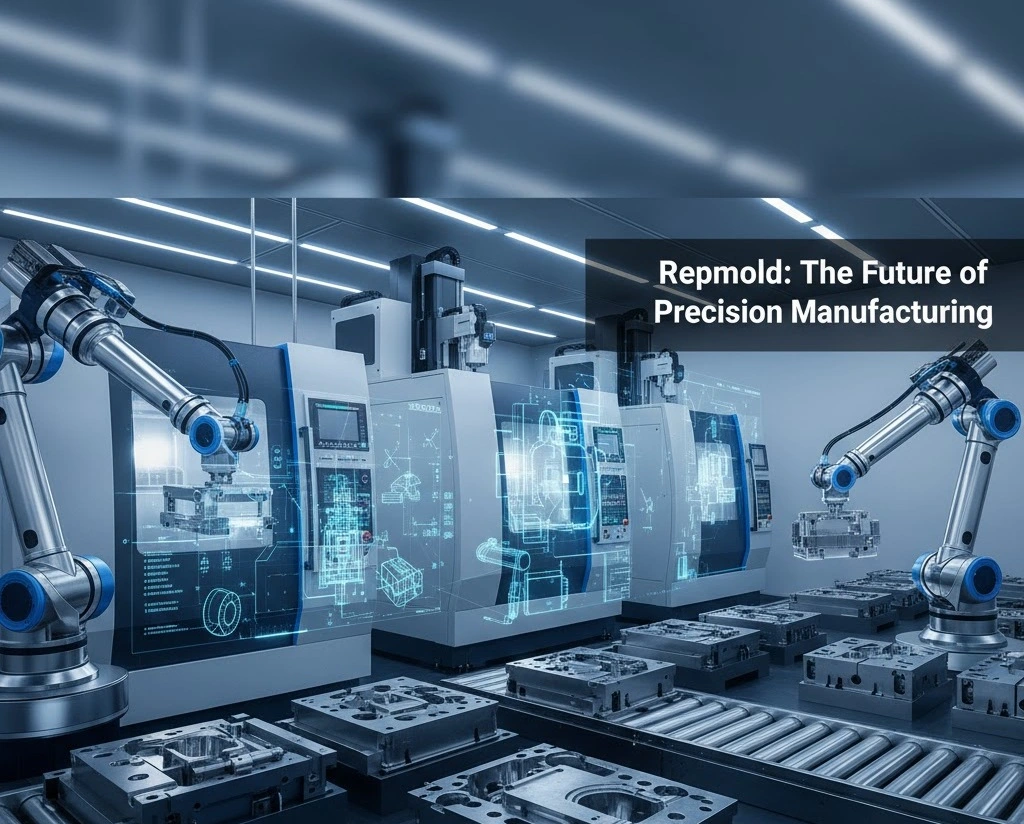
Modern manufacturing demands impossible choices: deliver faster, cut costs, go greener usually you pick two. Repmold technology refuses that compromise.
If you’ve spent months waiting for steel molds only to discover design flaws after production starts, you know the pain. UK manufacturers in automotive, medical devices, and electronics face this constantly. Traditional mold-making locks you into decisions before you’ve validated them in real conditions.
Repmold changes that completely. You’re looking at days instead of months, adaptable molds instead of rigid steel, and waste reduction of 40-60% compared to conventional machining. Here’s how it works and why UK businesses are making the switch.
What Repmold Actually Means
The term combines “replication” and “molding”—and that tells you everything about the approach. Instead of machining expensive steel molds from scratch for every project, repmold uses digital design, rapid prototyping, and validated master patterns that get replicated into production-ready molds.
Think of it as manufacturing’s response to software development. Design digitally, test quickly, iterate based on real feedback, then scale when you’re confident it works.
Traditional mold-making requires specialized machinists, weeks of labor, and major capital investment before you know if the design actually performs. Repmold flips that sequence. You validate first with quick prototypes, then commit resources only after you’ve proven the concept.
UK manufacturers particularly benefit from this approach. Shorter production timelines mean faster market entry—critical when competing against larger European and Asian manufacturers. The flexibility helps companies pivot when Brexit-related supply chain disruptions demand design changes.
How the Repmold Process Works
The methodology breaks into five connected phases, each building on digital data from the previous step.
Digital design and simulation comes first. Engineers model parts in CAD software and run virtual stress tests. You’re checking material flow, identifying weak points, and predicting potential defects—all before physical work begins. Modern simulation tools have gotten remarkably accurate at predicting real-world performance.
Rapid prototyping follows. This is where 3D printing or CNC machining creates master patterns. You’re not committing to expensive steel yet. Instead, you’re producing testable prototypes using the actual materials you plan for production. Those prototypes go through real testing—not just visual inspection, but functional validation under working conditions.
Once validated, the replication phase starts. Your proven master pattern becomes the template for creating multiple production molds. This replication maintains consistency across batches, which matters enormously in regulated industries like medical devices or automotive parts.
Production scaling happens next. Those replicated molds integrate with standard manufacturing processes—injection molding, die casting, whatever your production requires. The difference from traditional methods is speed and adaptability. Market conditions change? Customer feedback reveals improvements? You can modify and replicate new molds without starting from scratch.
Finally, continuous optimization closes the loop. Because repmold systems connect with digital workflows, performance data flows back to design teams automatically. You track wear patterns, spot efficiency improvements, and refine designs over time. It’s manufacturing with a feedback loop built in.
Why Speed Matters More Than Cost Savings
Yes, repmold reduces costs—we’ll cover that—but the strategic advantage comes from compressed timelines.
Consumer electronics companies refresh product lines every six months now. Automotive manufacturers face pressure to electrify fleets while regulations keep shifting. Medical device startups need to incorporate clinical feedback without blowing through funding. Traditional 8-12 week mold production can’t keep pace.
Repmold compresses that to 5-10 days. That’s not just convenient—it unlocks strategic options that weren’t feasible before.
You can test multiple design variations simultaneously. When a competitor launches a feature you need to match, you’re not stuck waiting on outdated tooling. You enter markets faster, gather real user data, and incorporate improvements in subsequent runs while competitors are still waiting on their first production molds.
For UK businesses competing globally, that time compression directly impacts market position. Being three months faster to market with a validated product beats being cheaper with an untested design.
The Real Cost Picture
Let’s be honest about numbers—repmold requires upfront investment. Advanced 3D printers, precision CNC machines, and simulation software aren’t cheap. Smaller manufacturers often see £50,000-£150,000 in initial setup costs depending on scale and capabilities.
However, the economics shift dramatically across a product’s lifecycle.
Traditional steel molds for automotive components run £40,000-£120,000 each. Design changes mean either scrapping that investment or expensive modifications that can cost 60-80% of the original price. Medical device companies report losing £200,000+ when regulatory feedback requires design changes after tooling is complete.
Repmold systems reduce per-mold costs by 40-60% in most applications. More importantly, they eliminate catastrophic losses from getting designs wrong. Testing with rapid prototypes before committing to production tooling saves companies from expensive failures that kill entire product lines.
Material waste drops significantly too. Traditional machining removes 60-80% of raw material as waste. Additive manufacturing builds only what’s needed. For companies running multiple products annually, those material savings compound quickly.
UK manufacturers also benefit from reduced inventory costs. Because you can produce molds faster, you don’t need to stockpile as many finished products. Just-in-time production becomes more feasible when tooling doesn’t represent a three-month bottleneck.
Precision Across Different Requirements
Manufacturing tolerances vary wildly by application. Consumer products might accept ±0.5mm variations. Aerospace components demand ±0.01mm precision. Medical implants need even tighter specifications with zero tolerance for contamination.
Repmold is digitized from the start and that gives the company the ability to handle the whole range of applications efficiently. The CAD models have the exact specifications. The simulation shows how the material will behave. In addition, automation eradicates human errors that cause variations common in traditional machining.
The replication phase ensures that all production runs are of the same quality. If you take molds from certified master patterns, every single one conforms to the original with tolerances that can be measured. The quality control will be quite predictable because you are replicating a standard that has already been proven rather than relying on individual machinists to match specifications manually.
Such consistency is very important in the case of UK companies serving regulated markets—medical devices, aerospace, automotive safety components—as it has a direct impact on compliance costs. The number of rejected parts is directly related to the number of costly retesting cycles that can, therefore, be reduced.
Real-World Applications Across Industries
Automotive manufacturers use repmold for dashboard components, engine parts, and custom modifications. Electric vehicle startups benefit particularly—they need to iterate quickly on battery housings, thermal management systems, and lightweight structural components. Traditional methods can’t match the iteration speed EV development demands.
Medical device companies rely on repmold for surgical instruments, diagnostic equipment housings, and custom prosthetics. Patient-specific implants based on CT scans represent a major advancement over one-size-fits-all approaches. UK medical device firms report 70% faster time-to-market for new devices using repmold methods.
Electronics manufacturers produce enclosures, connectors, and circuit board housings. The miniaturization trend in consumer electronics demands precision that traditional methods struggle to deliver consistently at scale. Repmold’s digital-first approach maintains tolerances even as component sizes shrink.
Aerospace applications focus on lightweight components where every gram impacts fuel efficiency. Repmold enables complex geometries that reduce weight while maintaining structural integrity—lattice structures and optimized shapes that would be impossible or prohibitively expensive with traditional machining.
Sustainability Benefits That Actually Matter
The environmental impact is a big concern for the consumers, investors, and regulators, however, the sustainability claims must be backed up with evidence.
Repmold causes waste to decline by 40% to 70% when compared to traditional machining and uses only the amount of material needed because of additive manufacturing. The energy used for each part is less because you don’t need to operate heavy machinery for weeks to remove the material.
The major environmental victory is through fewer design failures. If traditional molds do not meet the requirements, one has wasted materials, energy, and time on an entire production run. Repmold’s rapid prototyping detects problems earlier, thus eliminating that waste.
And, in the UK, companies that are going for B Corp certification or looking for ESG investors consider the sustainability profile of repmold to be very interesting. It is not greenwashing—it is much less resource-intensive than alternatives, and this has been measured.
Challenges You Need to Know About
Repmold, despite its benefits, is not a one-size-fits-all solution. In most cases, the production of millions of pieces per year still relies on the traditional approach and hardened steel molds. The steel’s longevity and resistance to wear and tear justify the cost when spread over large volumes.
Some cutting-edge materials and intricate shapes require more from the repmold than it can give. In such cases, it may be better to mix the old and the new techniques.
Moreover, the technology requires highly skilled workers who are well-versed in both digital design and physical manufacturing. This is a real problem for UK manufacturers in terms of the skills gap they will have to fill. The supply of engineering graduates who are capable of taking over the production line is not sufficient, whilst the experienced machinists still need to be trained on digital tools. The cost of that training is both real and continuous.
The high initial investment makes it difficult for small manufacturers to operate. However, the shared operations and cloud-based services have also just started emerging and are not yet accessible to the entire UK.
Looking Ahead: AI and Integration
The next evolution involves deeper integration with artificial intelligence and IoT sensors. Imagine molds monitoring their own performance in real-time, predicting maintenance needs before quality issues emerge.
AI systems could analyze production data across thousands of molds, identifying patterns human engineers might miss. Machine learning algorithms could optimize designs automatically, suggesting improvements based on performance data from similar applications globally.
Sustainable materials will play larger roles too. Biodegradable resins, recycled composites, and environmentally conscious production methods align with both regulatory pressures and market preferences. UK companies are already testing bio-based materials for consumer products where traditional molds can’t accommodate new material properties.
Making the Transition Practical
For UK manufacturers considering repmold, successful transitions start with specific applications where speed and flexibility deliver clear advantages.
Begin with product lines facing frequent design changes or where time-to-market creates competitive advantage. Test the approach with non-critical components before applying it to mission-critical parts. Learn what works for your specific applications without betting the business on unproven methods.
Invest in training for existing teams. Skills developed in traditional manufacturing translate but need augmentation with digital tools. Many UK technical colleges now offer repmold-specific training programs—take advantage rather than trying to train internally from scratch.
Partner with experienced providers initially rather than building all capabilities in-house. Service bureaus across the UK offer repmold capabilities on a project basis. Learn what works before committing to major capital investments.
The Bottom Line for UK Manufacturers
Repmold signifies not just quicker mold-making— it is a transition towards responsive and data-based manufacturing. Firms that adopt this technique will be able to change with the market and the customer demand perfectly.
It is no longer an issue of whether this technology will take over. It is a matter of whether your rivals will go for it before you do. Tooling time cut by three months means that the new products will have three months of monopoly in the market. This benefit multiplies when you consider the product launches happening throughout a year.
For the UK manufacturers that are already facing global competition, repmold is the way to get a competitive edge which requires neither large scale nor cheap labor. It takes full advantage of the UK manufacturing excellent features: precise engineering, fast innovation, and high-value specialized production.





